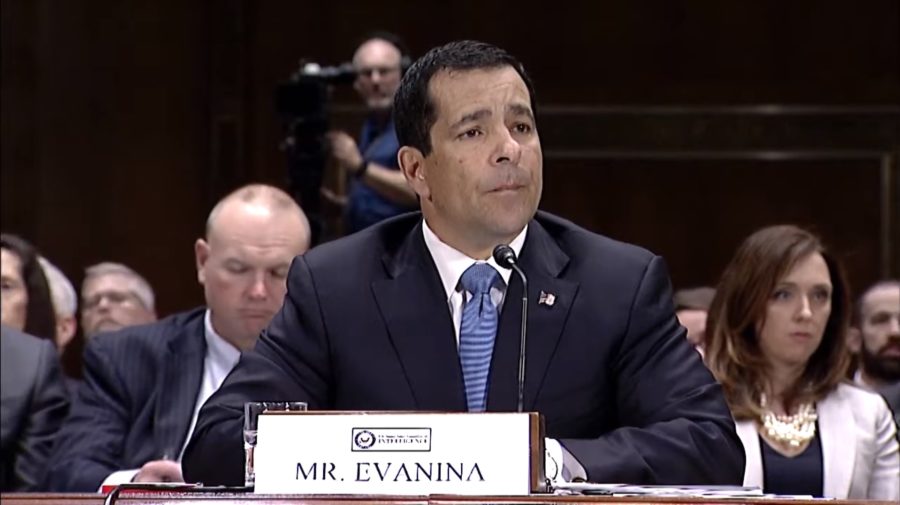
A recent statement issued by William Evanina (pictured), director of the US National Counterintelligence and Security Center (NCSC), warned the American public that other countries are using “covert and overt influence measures” to sway the vote. The Iranian regime is named one of three countries, alongside Russia and China, about which the NCSC is particularly concerned.
When it comes to what policies should be pursued towards the ruling mullahs of Iran, the difference between the former Vice President Joe Biden and President Donald J. Trump is striking.
The Trump administration has been in favor of the “maximum pressure” policy, cutting the flow of funds to the Iranian regime and its proxies, reducing Tehran’s oil exports, and isolating the regime in the region and globally. Now, the Iranian regime is facing an unprecedented level of pressure, which, if it continues, can threaten the ruling mullahs’ hold on power. As a result of this maximum pressure policy, the Iranian leaders have cut their funding to their allies, militia and terror groups.
Iran’s currency, the rial, which has been in free fall in the last few weeks, has plunged to a record low. As of August 22, 2020, a US dollar is now worth approximately 235,000 rials. Before the current US administration imposed a “maximum pressure” policy against Tehran, a US dollar had equaled nearly 30,000 rials. Iran’s oil exports have also sunk to a record low. The country’s budget heavily relies on selling oil. Three years ago, Iran was exporting roughly 2.5 million barrels of oil a day. According to the latest reports, Iran’s oil export is now around 70,000 barrels a day — a reduction of nearly 97%.
The 2020 Democratic nominee, Biden, will probably want to revive the Obama-era appeasement policies toward the ruling mullahs. This approach can mean lifting all the sanctions that the Trump administration has so far imposed on the ruling clerics, helping the mullahs rejoin the global financial system, and bringing Tehran out of isolation.
During the eight-year administration of former President Barack Obama, the president and Biden made unprecedented concessions, including the gift of “$150 billion, not to mention $1.8 billion in cash,” in an attempt to ingratiate themselves to the ruling mullahs. The Obama-Biden administration met the mullahs with generosity and flexibility every step of the way, including waiving inspections of military sites and the ultimate prize: permission at the “sunset” of the agreement for Iran to have deliverable nuclear weapons. What was the outcome?
As sanctions against Iran were lifted during the Obama-Biden administration, it quickly became clear that in the eyes of the international community, those actions gave Iran global legitimacy. This newfound legitimacy and the lifting of sanctions generated billions of dollars in revenue for Iran’s military and the Islamic Revolutionary Guard Corps, as well as for Iran’s proxy militias and terror groups. Tehran used that influx of revenues to expand its influence throughout the region and beyond, including in Syria, Iraq, Yemen, Lebanon, the Gaza Strip, Venezuela and the tri-border area of Argentina, Paraguay and Brazil. The expansion campaign proved to be immensely successful.
The Iranian regime will most likely do everything in its power to influence, meddle in and sway the 2020 US presidential election.
A recent statement issued by William Evanina, director of the US National Counterintelligence and Security Center (NCSC), warned the American public that other countries are using “covert and overt influence measures” to sway the vote. The Iranian regime is named one of three countries, alongside Russia and China, about which the NCSC is particularly concerned.
The Iranian regime has various ways of trying to influence the US election. The regime can, of course, employ sophisticated and skilled hackers to help, for example. According to a statement released by tech giant Microsoft, hackers linked to the Iranian government had already started targeting the 2020 election:
“Today we’re sharing that we’ve recently seen significant cyber activity by a threat group we call Phosphorus, which we believe originates from Iran and is linked to the Iranian government.
“In a 30-day period between August and September, the Microsoft Threat Intelligence Center (MSTIC) observed Phosphorus making more than 2,700 attempts to identify consumer email accounts belonging to specific Microsoft customers and then attack 241 of those accounts. The targeted accounts are associated with a U.S. presidential campaign, current and former U.S. government officials, journalists covering global politics and prominent Iranians living outside Iran.”
The Iranian regime, like other adversaries, can also spread misinformation, fake news and false narratives on social media platforms such as Twitter and Facebook. In 2018 alone, Facebook removed “652 pages, groups and accounts for coordinated inauthentic behavior that originated in Iran and targeted people across multiple Internet services.” The likes of Twitter and Google owner Alphabet have also identified hundreds of “inauthentic” accounts that seem to have originated in Iran.
By spreading false information, the regime is most likely attempting to advance specific narratives against the Trump administration, which would ultimately serve the interests of the mullahs and their militias, and strengthen the ruling clerics’ hold on power.
The American public needs to be extremely vigilant of the attempts by adversaries of the US to interfere in the upcoming election to manipulate the public vote in favor of the candidate who might be the most malleable in agreeing to their demands.
The post Watch for Election Meddling by Iran and Other Adversaries of America appeared first on Sovereign Nations.
– Sovereign Nations
